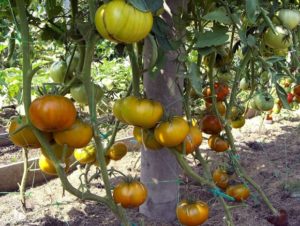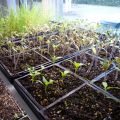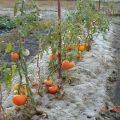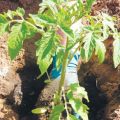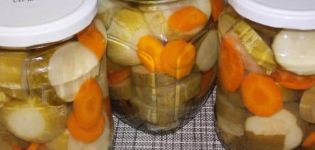Characteristics and description of the tomato variety Grandma's gift, its yield
Before growing tomatoes, everyone is engaged in choosing a variety that would be ideal for fulfilling their goals. Some growers grow vegetables for preserves and therefore opt for small-fruited tomatoes. People who like to eat fresh tomatoes prefer to grow varieties with excellent taste. However, there are versatile tomatoes that work for just about any purpose. One of these is a tomato Granny's gift.
Description
Before you start planting this variety, it is recommended that you familiarize yourself in more detail with its distinctive features. The characteristic and description will help to study in more detail the tomato Granny's gift f1.
This variety is a hybrid, so its seeds cannot be used for planting next year. The main advantages include the fact that the Grandmother's gift has a good yield and resistance to many tomato diseases, as evidenced by various reviews of gardeners. He almost never gets sick with fusarium, mosaic, powdery mildew and late blight.
Tomato bushes are indeterminate and tall. Under optimal conditions, they grow up to two meters. Plants are distinguished by a rather strong stem and a large number of leaves. They also have a powerful and branched root. Tomato leaves are rounded and colored dark green.
The variety belongs to late-ripening tomatoes, as the fruits begin to ripen 130 days after planting. To accelerate the ripening of tomatoes, it is recommended to plant them only in greenhouses.

Ripe tomatoes have a red skin, under which the flesh is rather juicy and tender. They are very large and heavy - each fruit weighs about 350 grams. Tomatoes have a sweetish taste with a slight sourness. They are used during the preparation of juices or ketchup.
Planting seeds
Before planting a tomato, Grandma's gift in the ground, you need to start growing seedlings. To do everything right, you should familiarize yourself in advance with the features of planting seeds for seedlings.
Seed preparation
Only the best seeds should be used for planting. Therefore, you first need to select high-quality planting material. For this, tomato seeds are calibrated.
First, all the seeds are placed in a container of brine and mixed for five minutes. Over time, seeds will float to the surface, which cannot be planted in the ground. They must be immediately removed from the solution and discarded.

The remaining planting material should be pre-processed. First, they should be soaked for half an hour in a weak manganese solution. Then they are placed in a container with warm water for an hour, after which they are dried and soaked overnight in an ash solution. This is done to completely disinfect the planting material.
Soil preparation
Before preparing the soil, you should start choosing a container in which it will be located. In this case, you will have to take into account several basic nuances. You cannot buy containers that are too deep, as this can cause the soil to acidify, which will lead to the appearance of diseases in the seedlings. Also, for planting seeds, you need to choose containers with special small-sized drain holes.
For planting seeds, it is not recommended to buy the cheapest soil or take it from a greenhouse. Such soil is very bad, since it cakes rather quickly and a dense crust appears on its surface.
The best choice is to buy coconut-based soil. Such soil is saturated with air and is rather loose.
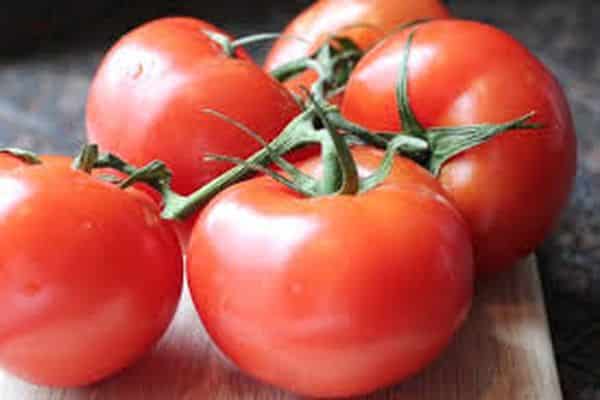
Many vegetable growers fertilize the soil before planting tomato seeds. However, this should not be done, since a large amount of nutrients can negatively affect seed germination. The soil for planting material should consist of two parts of sawdust and part of sand.
Landing
It is recommended to plant tomatoes for seedlings from March 1 to early April. For this, small holes about one centimeter deep are made in the landing containers. 3-4 seeds should be placed in each of them, after which all the holes are covered with earth, and the containers are covered with a lid or foil.
When growing seedlings, it is recommended to move all boxes with tomatoes to a room with good lighting. If the plants do not have enough light, they will grow more slowly. Daylight hours for tomatoes should be at least 10-12 hours.

Planting seedlings
First you need to figure out the timing of planting this variety. In the southern regions of Russia and Ukraine, it is necessary to plant seedlings in early May. However, residents of the central regions of the country will have to postpone this procedure to early June. Having decided on the deadlines, you can get to work.
Soil preparation
It is necessary to plant seedlings in pre-prepared soil. Young tomato seedlings need soil that is rich in nutrients. Only in this case will the plant develop normally and have a good yield.

A solution prepared from ten liters of water and a tablespoon of copper sulfate is added to the ground. The soil is watered in such a way that no more than one liter of the mixture is consumed per square meter of land. After that, you can add some mineral or organic fertilizers to the soil. Many vegetable growers add superphosphate, manure humus, sawdust.
Fertilizing the soil is necessary several weeks before planting seedlings.
Disembarkation
It is recommended to plant tomatoes on cloudy days or in the evening. The fact is that young seedlings do not tolerate the open sun in the first hours after planting and they need to be given time so that they can get used to the new conditions.
You need to plant seedlings so that neighboring bushes do not interfere with each other. Therefore, they are planted at a distance of at least 55-65 cm. You also need to monitor the distance between the rows, which should not be less than 70 cm.
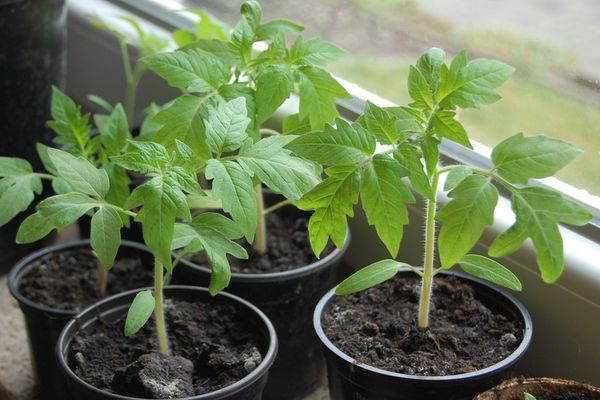
After creating the holes, you must carefully remove the seedlings from the pots. In this case, it is necessary to carefully monitor the earthen lump so as not to accidentally disturb it. The extracted seedlings are placed in an upright position in each hole, buried in earth and watered with water.
Conclusion
Every vegetable grower will be able to plant a Granny tomato as a gift. To do this, it is enough to familiarize yourself in advance with the description of the variety and the features of its planting in the ground.

